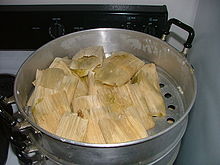Tamale (dish)

A tamale or tamal (from the Nahuatl tamalli) (plural tamales ) is a traditional Central American dish consisting of masa ( corn dough) filled with meat, cheese or other ingredients and wrapped in plant leaves and steamed. The preparation by the Mayans and Aztecs in the middle of the last millennium has been proven.
preparation
The preparation of tamales is relatively labor-intensive. In central and northern Mexico, the corn dough, which is often mixed with lard (mostly from pork), is spread on a plant leaf (mostly corn or banana leaves). Then the filling is placed lengthways in the middle of the sheet; Meat as part of the filling should already be pre-cooked. The sides of the sheet are folded towards the middle and the resulting package is usually secured with kitchen thread or some other type of string. The tamale is then steamed for 45 to 60 minutes until the dough has a cake-like consistency. Once prepared, the tamales can easily be frozen (the leaves prevent them from freezing together) and heated up as required. Cooking is often a social event where friends and relatives meet to make hundreds of tamales, which are then divided up.
In the meantime, food manufacturers specializing in Latin American dishes are offering tamales as frozen ready meals ; Dried corn leaves (hojas de tamal) are also sold packaged by the industry and must be soaked in warm water before use.
National variants
Mexico
In Mexico , tamales are a common breakfast dish and are sold in large pots ( tamaleras ) by street vendors . In some places like Zacatecas , the tamale is often placed in small wheat loaves and made into a torta de tamal . Common fillings include pork, lamb, or chicken with either red or green salsa or mole . For a variant that is often used for breakfast, sugar is added to the maize mixture, which is then filled with dried fruits, nuts, sweet beans and / or caramel to make a sweet tamale ( tamal de dulce ). A simple vegetarian alternative is the tamal de elote (corn tamale ).
Instead of corn leaves, banana leaves are used in tropical parts of the country, such as the countries bordering the Gulf of Mexico, Oaxaca , Chiapas and the Yucatán Peninsula . These tamales have a rather square shape, are usually very large (~ 40 cm) and thick. A typical variant, especially in Chiapas, is tamal de chipilin (filled with spicy chipilin herbs; a common name for these tamales in southern Tamaulipas is Zacahuil ). These banana leaf tamales are also very common in the countries of Central America bordering southern Mexico. To get a full meal, tamales are often served with atole , hot chocolate or champurrado .
Peru
Peruvian tamales are usually very spicy, larger and wrapped in banana leaves. They are usually filled with chicken or pork and are served with boiled eggs, olives, peanuts, or a piece of chilli pepper. The corn dough is often colored with annatto . Smaller tamales include the humitas wrapped in corn leaves, usually filled with sweetness, and the green tamalitos verdes made from corn dough mixed with coriander.
United States
The plural tamales is the most common form used in the United States. The dish has now become very popular there, and fillings with, for example, beef or chopped corn kernels are also used. Tamales are also a popular Christmas dish in the southwestern United States and a common meal in the Lower Mississippi Delta region . Their popularity grew since the early 19th century when Mexican harvest workers introduced them to black workers on cotton plantations in the southern United States.
Other countries
The common form of tamales in Nicaragua are called nacatamales . In El Salvador and Honduras , as in southern Mexico and Nicaragua, the tamales are also served in banana leaves. There are different variants such as tamal de gallina (chicken), tamal pisque (fish) and tamal de elote . In Guatemala there are also variants without filling that are served as a filling side with a meal, such as tamal blanco (white tamales).
In Colombia , too, there are tamales, which are called hallacas ; cooking in banana leaves is common there. In Ecuador , tamales and humitas are filled with fresh cheese, pork, chicken or raisins. Usually the Ecuadorian tamales are wrapped in corn or achira leaves. Tamales are also very common in Belize . There they are also known under the name Bollo and using the plural as a singular as a tamales .
Web links
Individual evidence
- ↑ The Nutritional History of Mesoamerica on Foodtimeline.org
- ↑ Linda Bladholm: Latin & Caribbean Grocery Stores Demystified . Renaissance Books, Los Angeles 2001, ISBN 1-58063-212-2 , pp. 63 .
- ↑ Linda Bladholm: Latin & Caribbean Grocery Stores Demystified . Renaissance Books, Los Angeles 2001, ISBN 1-58063-212-2 , pp. 133 .
- ↑ Colombia.co: Typical Colombian Foods You Should Definitely Try While Visiting Colombia. Retrieved May 10, 2018 .
